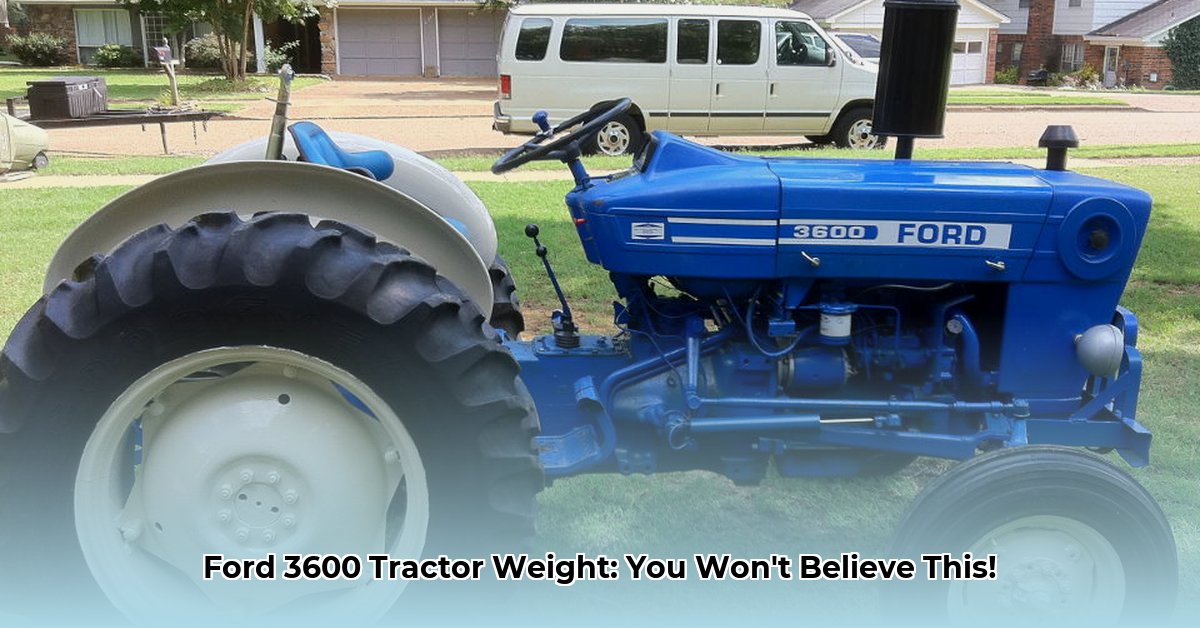
The Ford 3600: a name synonymous with reliability and agricultural prowess. Produced from 1975 to 1981, this iconic tractor continues to hold a special place in the hearts of farmers and collectors alike. But beyond its nostalgic appeal lies a wealth of technical details, market insights, and restoration know-how that this comprehensive guide explores. Understanding the Ford 3600's weight – a key factor influencing its handling, functionality, and value – is critical for anyone interested in this classic machine. For more on tractor weights, see this helpful resource: Tractor Weights.
Ford 3600 Weight and Technical Specifications
The weight of a Ford 3600 isn't a single number; it varies. Expect a range of approximately 4,600 to 5,000 pounds, depending on several factors. The model variant (Utility, 3600-N Narrow Row, or 3600-O Orchard), added implements (like a plow or front-end loader), and the amount of ballast used for improved stability all contribute to this weight variation. Think of it like a car: a base model weighs less than one equipped with extra features and filled with passengers.
The heart of the 3600 is its 2.9-liter, three-cylinder engine, available in gasoline or diesel configurations. Power output typically ranged from 45 to 48 horsepower, subject to variations in fuel type and testing methodology. This power, coupled with its relatively lightweight build for its capabilities, gave the 3600 a remarkable power-to-weight ratio, making it remarkably maneuverable even on challenging terrain.
Beyond the engine, the 3600 boasted features ahead of its time, notably power steering—a significant boon to operator comfort. Transmission choices included 6-speed or 8-speed manual gearboxes, offering versatility for diverse farming operations. This combination of power, manageable weight, and user-friendly features firmly cemented its place as a versatile and capable farm machine.
| Specification | Details | Notes |
|---|---|---|
| Approximate Weight (lbs) | 4,600 - 5,000 | Varies by model, added equipment, and ballast |
| Engine | 2.9L 3-cylinder; Gasoline or Diesel | Horsepower varied (45-48 hp) due to fuel and testing methods |
| Horsepower | Approximately 45-48 hp | Testing methodologies influenced recorded power output |
| Transmission | 6-speed or 8-speed manual | Gear ratios optimized for various tasks |
| Steering | Power steering | Enhanced maneuverability and operator comfort |
Market Value and Collectibility of the Ford 3600
The current market value of a Ford 3600 is highly dependent on its condition. A meticulously restored example in pristine condition commands a significantly higher price than one requiring extensive repairs. Rarity also plays a role; the 3600-N (Narrow) and 3600-O (Orchard) variants, designed for specific applications, often fetch premium prices. The availability of replacement parts is another crucial factor; readily available parts simplify restoration and increase overall value.
Considering that a new 3600 cost approximately $7,200 in 1981, its appreciation over the years underscores its enduring appeal among collectors. Just like classic cars, the condition and rarity of a Ford 3600 dictate its market standing. Careful evaluation is crucial before purchasing, balancing restoration potential with the investment required.
Restoring Your Ford 3600: A Practical Guide
Restoring a Ford 3600 is a rewarding undertaking, demanding both mechanical skills and perseverance. Follow these steps for a successful restoration:
Comprehensive Inspection: Begin with a thorough inspection, documenting everything—photographing damage, noting missing parts, and assessing the overall condition. This detailed record is essential throughout the restoration.
Parts Sourcing: Locate needed components. Online marketplaces, specialized tractor parts suppliers, and salvage yards are valuable resources. Be prepared for a thorough search!
Disassembly: Carefully disassemble the tractor, thoroughly documenting each step with photos and notes. Label and store all parts appropriately.
Cleaning and Repair: Clean each component thoroughly. Repair or replace damaged parts.
Reassembly: Carefully reassemble, using your detailed documentation as a guide. Ensure everything is aligned correctly and firmly secured.
Testing: After reassembly, test all systems (engine, transmission, hydraulics, steering). Resolve any issues before full operation.
Common Restoration Challenges:
Some consistent problems include the hydraulic system, transmission, and potential engine leaks. Accurate diagnosis is critical before tackling these.
Safety First:
- Always disconnect the battery before beginning any maintenance or repairs.
- Work in a well-ventilated area to avoid carbon monoxide poisoning.
- Consult the owner's manual for specific safety procedures and instructions.
Conclusion: A Lasting Legacy
The Ford 3600 remains a testament to robust engineering and enduring design. Its continued popularity among collectors and enthusiasts highlights its lasting impact on agriculture and the fascination with classic machinery. This guide offers a starting point, and further research and consultation with experts will prove invaluable for those embarking on the journey of owning, maintaining, or restoring this iconic tractor. Understanding the weight, its variations, and the restoration process is critical for both practical application and appreciating the historical significance of this mechanical marvel.